Orangutans in Borneo | Our Rainforest Adventure

The best place to see orangutans in the wild is Tanjung Puting National Park on the island of Borneo. There are said to be 6000 orangutans in the park. Borneo is shared by three countries: Indonesia, Malaysia, and Brunei. Tanjung Puting is in Indonesian Borneo, which is known as Kalimantan. Wild orangutans are found only on Borneo and Sumatra.
What to expect from a klotok tour of Tanjung Puting
Most people book a tour of Tanjung Puting National Park. The tour is usually two days and two nights. Take a klotok (houseboat) down the river into the national park, stopping at orangutan feeding stations.
Day 1
09:30-11:30 – Fly from Jakarta airport to Pangkalan Bun (Iskandar Airport)
11:30-12:30 – Airport transfer from Pangkalan Bun to Kumai
12:30 – Eat lunch on the boat, meet the crew
12:30-14:30 – Take the klotok downriver to the Tanjung Harapan station
15:00-17:00 – Watch the orangutans feeding!
17:30-18:30 – Look for proboscis monkeys and crocodiles on the river bank
18:30 – Candlelit dinner aboard the klotok
19:30-20:30 – Take a guided night walk into the jungle
21:00+ – Sleep aboard the klotok
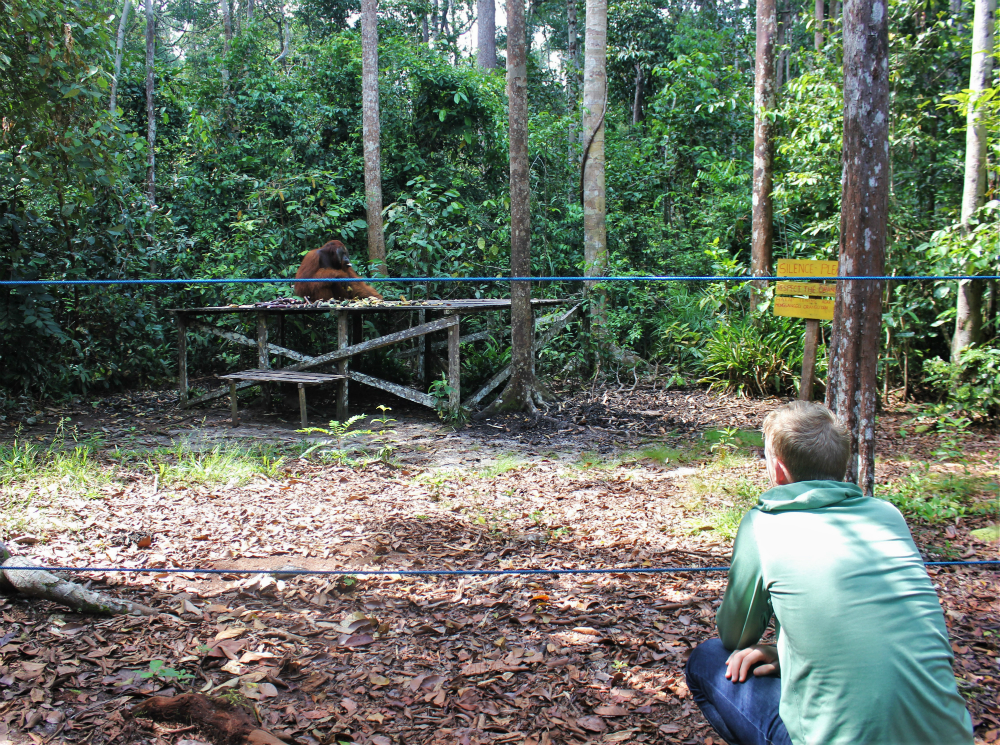
Day 2
07:30 – Breakfast aboard the klotok
07:30-8:30 – Head to Pondok Tanggui orangutan feeding station
09:00-11:00 – Watch the orangutans feed
11:45 – Lunch aboard the klotok
11:45-13:00 – Head downriver to Camp Leakey
14:00-16:00 – Watch the final orangutan feeding. Maybe see wild boars too!
18:30 – Dinner aboard the klotok
18:30-20:00 – Head back down the river. Stop to watch fireflies in the palm trees. Sleep.

Day 3
On the final day, you’ll wake up for breakfast and arrive back at Kumai at around 10:00. A taxi will take you to your hotel or to the airport. From here you can spend the day in the village of Pangkalan Bun (see the final section of this blog).
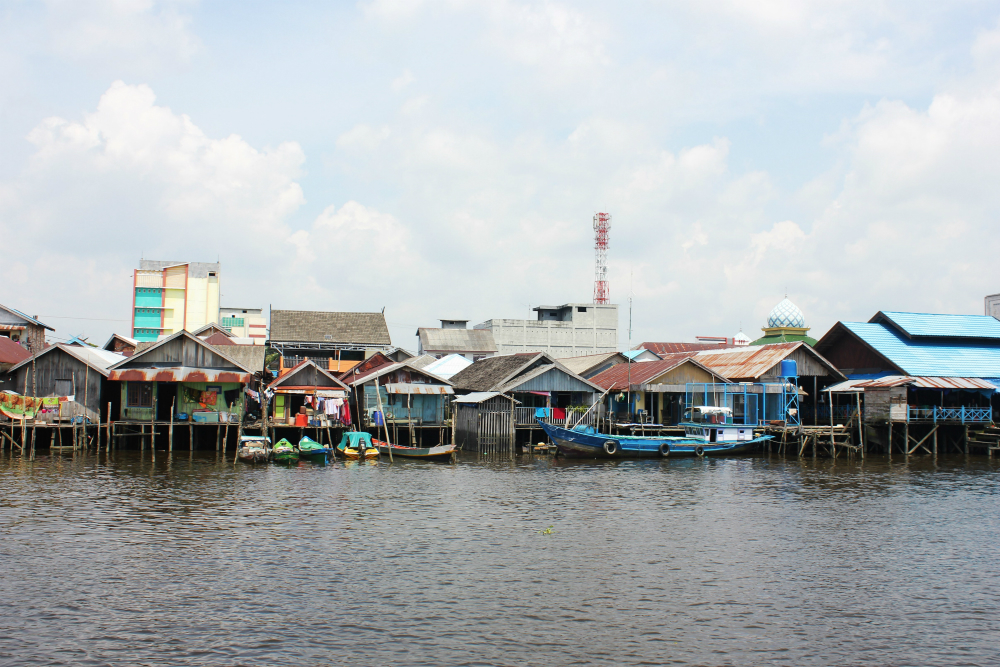
You can book a tour with Jenie through this link. Jenie speaks good English and is available on Whatsapp. We paid 2,500,000 Indonesia Rupiah per person. A portion of the profits will be used to conserve the rainforest.
Are the orangutans in Tanjung Puting National Park endangered?
The feeding stations are for semi-wild orangutans. These are orangutans who have been rescued from captivity and have been released into the park. Recently, Indonesian law was changed so that ex-captive orangutans are no longer released into areas where there are already wild orangutans.
The feeding stations are located in clearings. Orangutans and tourists are separated by a rope. Tourists are asked to be silent, not to bring any food and not to use flash photography. Touching the orangutans is forbidden. The rangers arrive at set times with bananas and sugarcane. These are placed on the feeding platforms. Orangutans swing through the trees to the feeding station when it’s time to eat.
There are also wild orangutans in the park. You’re most likely to see these beautiful creatures from the klotok — so keep your eyes peeled! We saw wild orangutans a number of times.

How much does it cost to see orangutans in Borneo?
We paid 2,500,000 IDR per person for the tour. The lowest price I’ve seen is just under 2,000,000 IDR. In total, we paid 4,750,000 IDR per person for the orangutan tour, internal flights to and from Kalimantan, antimalarials and a night in Pangkalan Bun (four days and three nights in Borneo). That’s about £265 or $350.
We paid the following:
- 2,500,000 IDR per person for the two-night orangutan tour
- 70,000 IDR for doxycycline (antimalarials)
- 275,000 IDR for a night’s accommodation in Pangkalan Bun
- 50,000 IDR per meal in Pangkalan Bun
- 900,000 IDR for flights from Jakarta to Pangkalan Bun
- 850,000 IDR for flights from Pangkalan Bun to Semarang (Java, Indonesia)
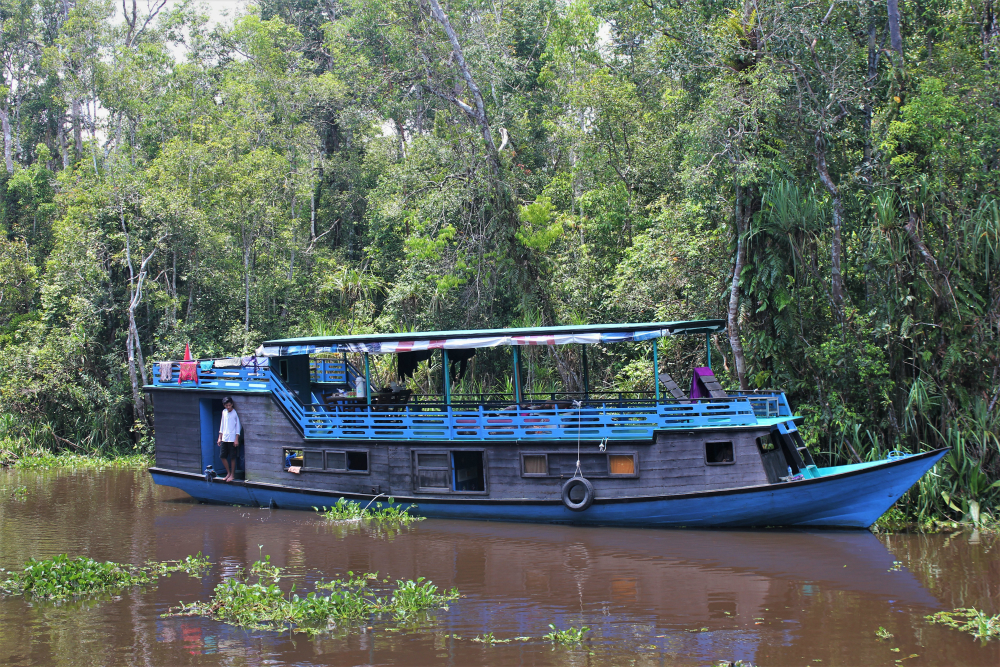
What is a klotok?
A klotok (named for the “tok tok” noise made by the engine) is a simple houseboat. There is an upper deck, a lower deck and a roof. The upper deck contains a dining table and chairs, as well as a sink. The lower deck contains the crew’s quarters and kitchen.
Klotoks will often have a toilet (flushed by bucket) and a simple shower (often cold). You’ll sleep on a simple mattress on the upper deck, protected by a mosquito net. Tarpaulin sheets come down to block out light and provide a little privacy. The conditions are spartan, but the crew make the sleeping arrangements nice enough. Klotoks do have electricity.
The cook will prepare your food: steamed rice, fried rice, fried noodles, vegetable dishes, meat dishes, tofu/tempeh dishes and fresh fruit. We’re vegetarian and we well catered for; just let them know in advance. There’s hot water for tea and instant coffee. Bottled water is provided as well as fizzy drinks.
Klotoks are crewed by a captain, an assistant, a cook and a guide.
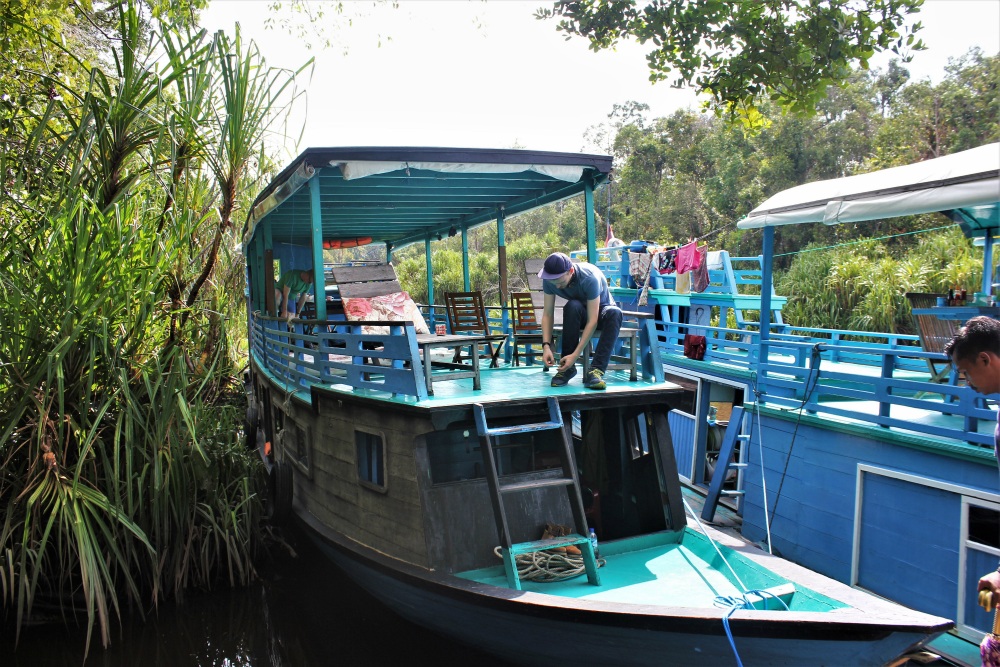
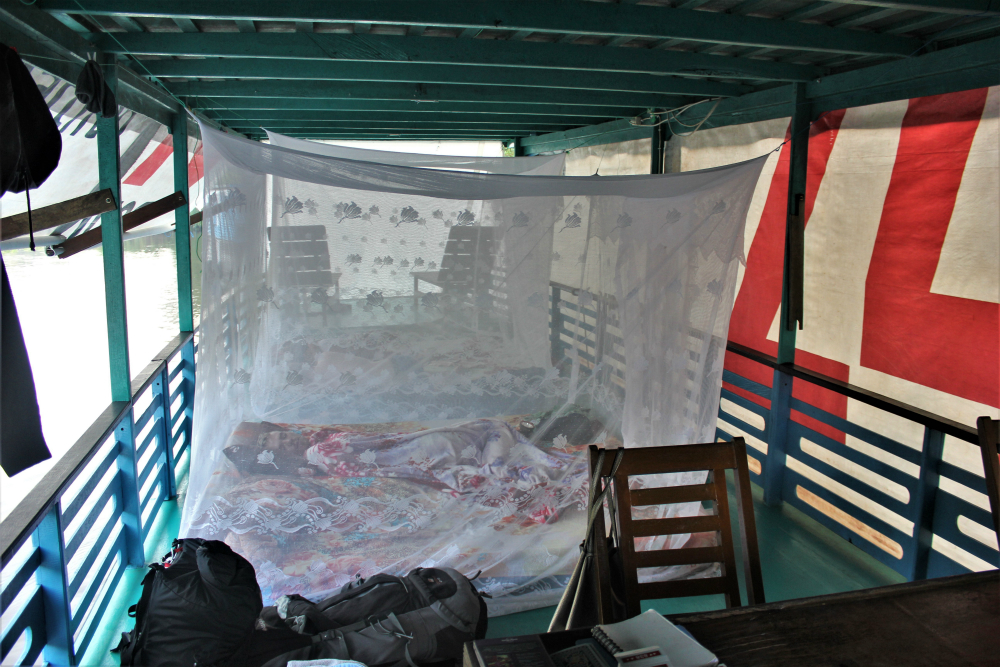
Basic sleeping conditions on the top deck of the klotok
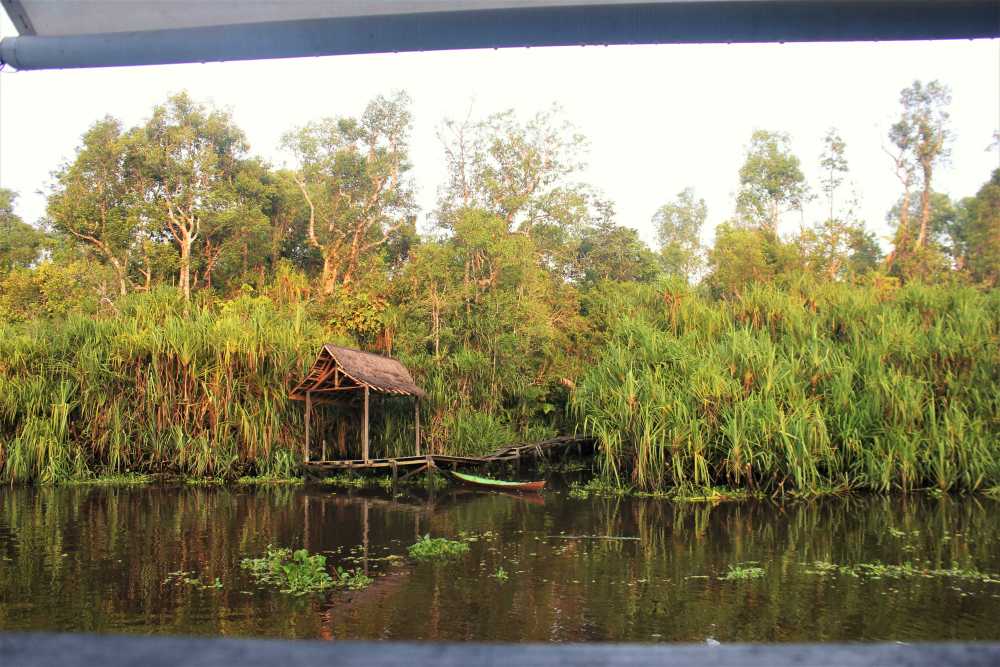
The view from bed on the morning of Day 2
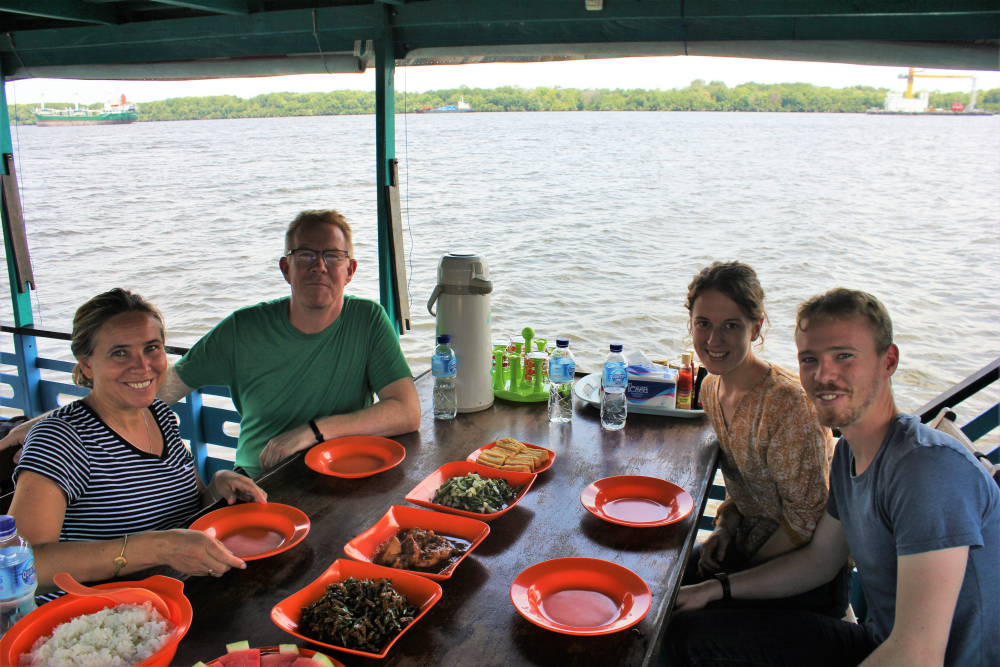
Vegetarian-friendly lunch on the klotok
What’s the best time of year to see Orangutans in Tanjung Puting National Park?
High season is July, August and September. It can be very crowded on the river. Our guide said that during this season there are sometimes queues of boats.
The rainy season is December, January and February… supposedly.
I noticed different sources giving different dates for rainy season, so I checked the weather data for Pangkalan Bun in 2016. In that year, January and October were substantially wetter than any other months, with November and December having similar rainfall to months in the dry season. The third wettest month was actually March. The driest month was August.
In conclusion, rain is hard to predict in the rainforest — rainy season may start a little early and some months of rainy season might be quite dry! My advice would be to pack a waterproof and hope for the best.
We visited in late October 2017. We may have been lucky, but the weather was excellent (mostly blue skies and not a drop of rain). There were other klotoks on the river, but enough space so that the park didn’t feel crowded.
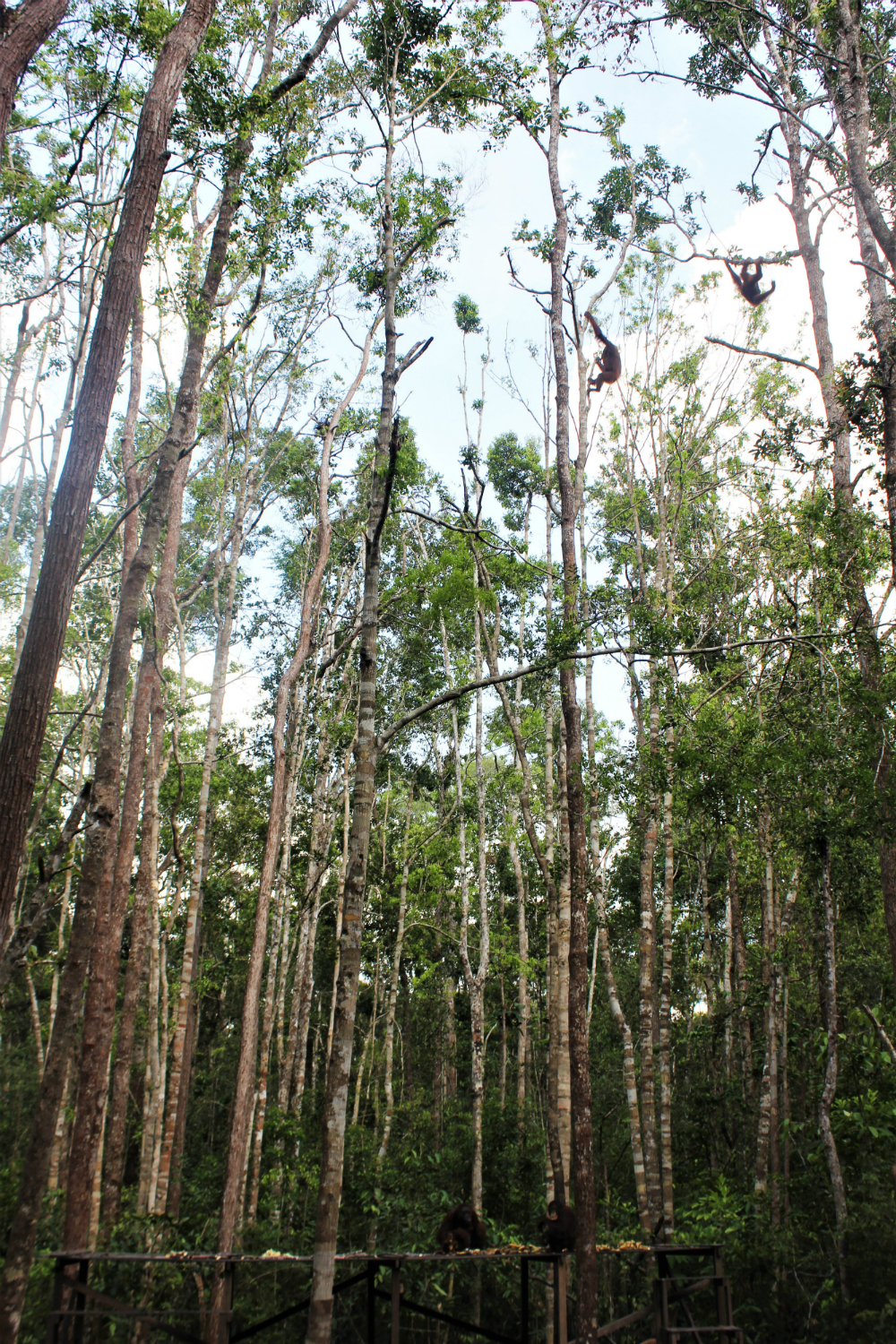
What animals can you see in Tanjung Puting National Park in Borneo, Indonesia?
- Orangutans – the name means “forest people” in Indonesia.
- Proboscis Monkeys – “Dutch monkeys” with big, flat noses found only on Borneo.
- Long-tailed Macaques – a monkey found widely across Asia.
- Tarsiers Nocturnal – a monkey no bigger than your hand!
- Saltwater Crocodiles – the largest in the world.
- Hornbills – distinctive bird with a horned peak.
- Pythons – this large snake is a good swimmer.
- Wild boars – we saw these guys at Camp Leakey!
More rarely seen are gibbons, sun bears and clouded leopards.
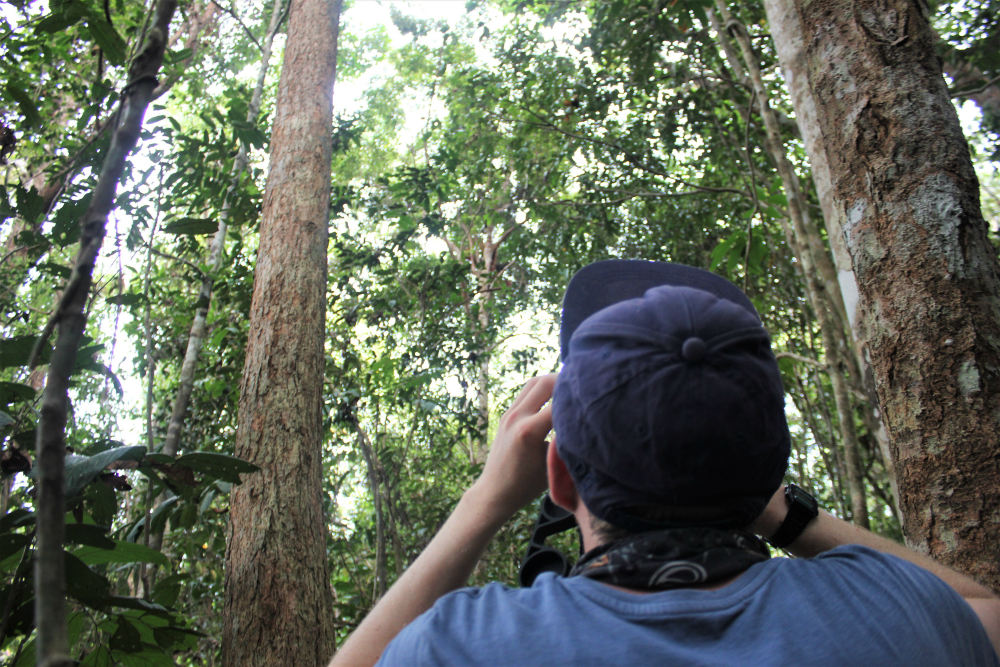
Is there malaria in Tanjung Puting National Park in Borneo, Indonesia?
My local doctor told us that there was malaria in Borneo. However, our guide said that the last case of malaria was in 2008. We took the antimalarials anyway, thinking it better to be safe rather than sorry.
To prevent mosquito bites:
- Cover up with long clothing
- Use a mosquito repellent that contains DEET
- Sleep under a mosquito net
- Use a mosquito coil
When we visited in late October, there were much fewer mosquitoes than I expected! I just got a handful of bites.
There are two main antimalarial medicines: doxycycline and Malarone.
Doxycycline is…
- Cheaper than Malarone
- Taken once per day (100 mg) at the same time each day
- Taken after food and with a glass of water
- You cannot lie down for an hour after taking doxy
- You cannot drink anything with dairy for an hour after taking doxy
- Taken for one or two days before visiting a malaria zone
- Taken daily while in a malaria zone
- Taken for 28 days after visiting the malaria zone
- Safe with the contraceptive pill, so long as you are not sick
- Prone to side effects. Check with your doctor
- An antibiotic, but not enzyme-inducing
- Available in Jakarta (at Roxy Apotek)
Malarone is…
- More expensive than doxy
- Taken one to two days before visiting a malaria zone
- Taken once per day (250/100 mg) at the same time each day
- Taken every day while in a malaria zone
- Taken with food (or a milky drink)
- Prone to side effects. Check with your doctor
- Not widely available in Jakarta
I’m not a doctor! Talk to a qualified health professional about the risks of malaria.
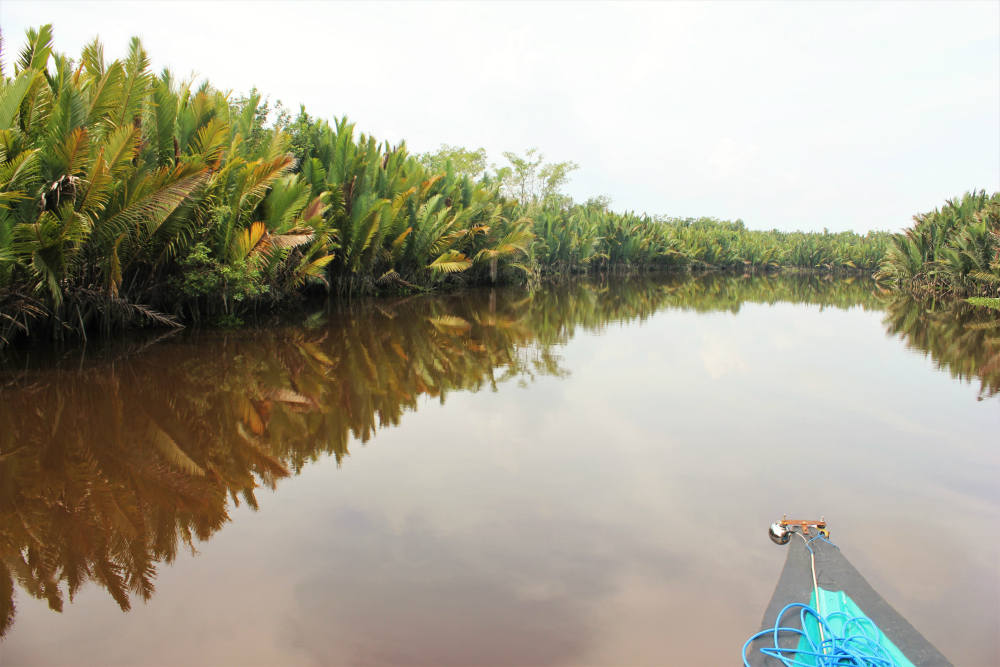
What should I bring and wear while seeing orangutans in Borneo?
In addition to our usual travel equipment and the antimalarials mentioned above, I recommend taking a decent pair of binoculars. These helped me get a good look at distant wild orangutans, and proboscis monkeys!
You should also take:
- Baby wipes
- Medical kit
- Toiletries, including soap and shampoo
- Sunscreen
- Waterproof and light clothing
Deforestation, palm oil and what you can do to help orangutans
Deforestation is a major problem in Borneo. Palm oil companies are burning down the rainforest to make way for palm plantations. Already 75% of the rainforest has been destroyed. They are destroying the natural habitat of orangutans. The species are now endangered and need help!
We travelled with a local guide and family who run their tours sustainably. Jenie, who runs the tours, uses the proceeds from the tours to buy unprotected rainforest land which is home to the orangutans to prevent palm oil companies from buying up and burning the land.
You don’t have to be a Kalimantan local or buy land to help prevent this atrocity. You can help the orangutans by not buying or using products which contain palm oil (unless marked with a sustainable palm certificate). Palm oil is an ingredient used in many foods that you won’t even realise. These foods include some brands of peanut butter, supermarket granola, some brands of ice cream, some brands of packaged bread, some types of biscuits. It’s also in some brands of cosmetics such as lipstick. Check the label before you buy and help boycott palm oil. A full list of products using palm oil is available on the WWF website.

Where can I stay in Pangkalan Bun?
Most travellers skip right past Pangkalan Bun, which admittedly seems like the correct decision at first glance. But I have fond memories of the night we spent in town: smiling children came and practised their English, everyone was super friendly and waved and smiled at us, and the walk along the waterfront was a great way to catch a glimpse of village life on the river. We even saw a traditional Javanese dance and took a boat up the river (and made the captain’s day when we paid him 40,000 IDR for the ride).
We stayed at the Tiara Hotel, which was basic but had wifi and air conditioning (275,000 IDR). We ate at Cafe Iduna and at Warung Cak-Cek. At Cak-Cek the whole family came out to listen to our order and they were over the moon to have foreigners visit their restaurant. The food at Cafe Iduna was okay. The food at Warung Cak-Cek was excellent.

A boat ride with a local down the river in Pangkalan Bun
If you’d like to learn more about orangutans and the work done in Tanjung Puting National Park (as well as volunteering opportunities) check out the orangutang.org website. Lastly, take a look at the Tanjung Puting Instagram to see current photos from inside the park.
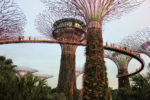

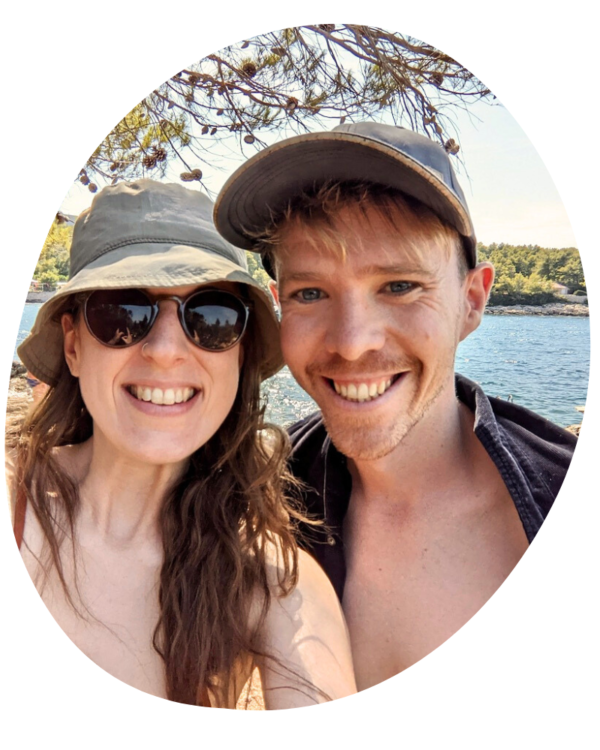


Shelby Morrison
I’m usually very put off by tours, either they are very touristy and gimmicky or they exploit someone or something. However, this seems like a great tour to change my mind. The animals seem protected, not exploited, and the method of the tour seems very sustainable. I would love to get up close and see animals in the wild but am always worried about them being exploited. This looks like a truly once in a lifetime experience and one I’m adding to my bucket list. Fantastic guide and you’ve changed this girl’s opinion on guided tours. I won’t be adding a host of tours to my trips, but this is proof that the select tour can be truly magical.
Charlie Marchant
Hey Shelby. I completely agree with you and I also tend to not be keen on taking tours. As you say, there is often a lot of time waiting around, gimmicks and being taken to restaurants and shops and such. In this case, it was a very different experience. It’s not possible to enter the National Park without a klotok (boat) or a speedboat – though it is possible to rent one and organise your trip in a more DIY style. Unfortunately, this way is much more difficult, especially if you don’t speak the local language or if you don’t have some time beforehand in the local area. The orangutan feeding stations are only open at specific intervals and the tours are planned around these times, rather than having lots of groups of tourists traipsing through the jungle and disturbing orangutans.